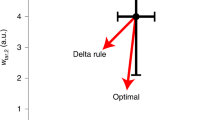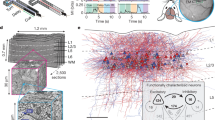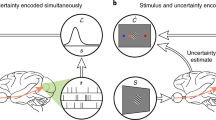Abstract
We propose that synapses may be the workhorse of the neuronal computations that underlie probabilistic reasoning. We built a neural circuit model for probabilistic inference in which information provided by different sensory cues must be integrated and the predictive powers of individual cues about an outcome are deduced through experience. We found that bounded synapses naturally compute, through reward-dependent plasticity, the posterior probability that a choice alternative is correct given that a cue is presented. Furthermore, a decision circuit endowed with such synapses makes choices on the basis of the summed log posterior odds and performs near-optimal cue combination. The model was validated by reproducing salient observations of, and provides insights into, a monkey experiment using a categorization task. Our model thus suggests a biophysical instantiation of the Bayesian decision rule, while predicting important deviations from it similar to the 'base-rate neglect' observed in human studies when alternatives have unequal prior probabilities.
This is a preview of subscription content, access via your institution
Access options
Subscribe to this journal
Receive 12 print issues and online access
$209.00 per year
only $17.42 per issue
Buy this article
- Purchase on Springer Link
- Instant access to full article PDF
Prices may be subject to local taxes which are calculated during checkout






Similar content being viewed by others
References
Knowlton, B.J., Squire, L.R. & Gluck, M.A. Probabilistic classification learning in amnesia. Learn. Mem. 1, 106–120 (1994).
Knowlton, B.J., Mangels, J.A. & Squire, L.R. A neostriatal habit learning system in humans. Science 273, 1399–1402 (1996).
Moody, T.D., Bookheimer, S.Y., Vanek, Z. & Knowlton, B.J. An implicit learning task activates medial temporal lobe in patients with Parkinson's disease. Behav. Neurosci. 118, 438–442 (2004).
Fera, F. et al. Neural mechanisms underlying probabilistic category learning in normal aging. J. Neurosci. 25, 11340–11348 (2005).
Ashby, F.G. & Maddox, W.T. Human category learning. Annu. Rev. Psychol. 56, 149–178 (2005).
Yang, T. & Shadlen, M.N. Probabilistic reasoning by neurons. Nature 447, 1075–1080 (2007).
Gold, J.I. & Shadlen, M. Neural computations that underlie decisions about sensory stimuli. Trends Cogn. Sci. 5, 10–16 (2001).
Gold, J.I. & Shadlen, M.N. The neural basis of decision making. Annu. Rev. Neurosci. 30, 535–574 (2007).
Soltani, A. & Wang, X.-J. A biophysically-based neural model of matching law behavior: melioration by stochastic synapses. J. Neurosci. 26, 3731–3744 (2006).
Soltani, A., Lee, D. & Wang, X.-J. Neural mechanism for stochastic behavior during a competitive game. Neural Netw. 19, 1075–1090 (2006).
Fusi, S., Asaad, W.F., Miller, E.K. & Wang, X.-J.Aneural circuit model of flexible sensorimotor mapping: learning and forgetting on multiple timescales. Neuron 54, 319–333 (2007).
Fusi, S., Drew, P.J. & Abbott, L.F. Cascade models of synaptically stored memories. Neuron 45, 599–611 (2005).
Fusi, S. & Abbott, L.F. Limits on the memory storage capacity of bounded synapses. Nat. Neurosci. 10, 485–493 (2007).
Wang, X.-J. Probabilistic decision making by slow reverberation in cortical circuits. Neuron 36, 955–968 (2002).
Wong, K.-F. & Wang, X.-J. A recurrent network mechanism of time integration in perceptual decisions. J. Neurosci. 26, 1314–1328 (2006).
Wong, K.-F., Huk, A.C., Shadlen, M.N. & Wang, X.-J. Neural circuit dynamics underlying accumulation of time-varying evidence during perceptual decision making. Front. Comput. Neurosci. 1, 6 (2007).
Furman, M. & Wang, X.-J. Similarity effect and optimal control of multiple-choice decision making. Neuron 60, 1153–1168 (2008).
Liu, F. & Wang, X.-J. A common cortical circuit mechanism for perceptual categorical discrimination and veridical judgment. PLOS Comput. Biol. 4, e1000253 (2008).
Wang, X.-J. Decision making in recurrent neuronal circuits. Neuron 60, 215–234 (2008).
Gluck, M.A. & Bower, G.H. From conditioning to category learning: an adaptive network model. J. Exp. Psychol. Gen. 117, 227–247 (1988).
Amit, D.J. & Fusi, S. Dynamic learning in neural networks with material synapses. Neural Comput. 6, 957–982 (1994).
Fusi, S. Hebbian spike-driven synaptic plasticity for learning patterns of mean firing rates. Biol. Cybern. 87, 459–470 (2002).
Meeter, M., Myers, C.E., Shohamy, D., Hopkins, R.O. & Gluck, M.A. Strategies in probabilistic categorization: results from a new way of analyzing performance. Learn. Mem. 13, 230–239 (2006).
Myers, J.L. Probability learning and sequence learning. in Handbook of Learning and Cognitive Processes (ed. Estes, W.K.) 171–205 (Erlbaum, Hillsdale, New Jersey, USA, 1976).
Vulkan, N. An economist's perspective on probability matching. J. Econ. Surv. 14, 101–118 (2000).
Shanks, D.R., Tunney, R.J. & McCarthy, J.D. A re-examination of probability matching and rational choice. J. Behav. Decis. Mak. 15, 233–250 (2002).
Kahneman, D. & Tversky, A. On the psychology of prediction. Psychol. Rev. 80, 237–251 (1973).
Tversky, A. & Kahneman, D. Evidential impact of base rates. in Judgment Under Uncertainty: Heuristics and Biases (eds. Kahneman, D., Slovic, P. & Tversky, A.) 153–160 (Cambridge Univ. Press, Cambridge, UK, 1982).
Kruschke, J.K. ALCOVE: an exemplar-based connectionist model of category learning. Psychol. Rev. 99, 22–44 (1992).
Glimcher, P.W. The neurobiology of visual-saccadic decision making. Annu. Rev. Neurosci. 26, 133–179 (2003).
Sugrue, L.P., Corrado, G.C. & Newsome, W.T. Matching behavior and representation of value in parietal cortex. Science 304, 1782–1787 (2004).
Sugrue, L.P., Corrado, G.S. & Newsome, W.T. Choosing the greater of two goods: neural currencies for valuation and decision making. Nat. Rev. Neurosci. 6, 363–375 (2005).
Soltani, A. & Wang, X.-J. From biophysics to cognition: reward-dependent adaptive choice behavior. Curr. Opin. Neurobiol. 18, 209–216 (2008).
Ma, W.J., Beck, J.M., Latham, P.E. & Pouget, A. Bayesian inference with probabilistic population codes. Nat. Neurosci. 9, 1432–1438 (2006).
Beck, J.M. et al. Probabilistic population codes for bayesian decision making. Neuron 60, 1142–1152 (2008).
Ma, W.J., Beck, J.M. & Pouget, A. Spiking networks for bayesian inference and choice. Curr. Opin. Neurobiol. 18, 217–222 (2008).
Rushworth, M.F.S. & Behrens, T.E.J. Choice, uncertainty and value in prefrontal and cingulate cortex. Nat. Neurosci. 11, 389–397 (2008).
Lee, K.-M. & Keller, E.L. Neural activity in the frontal eye fields modulated by the number of alternatives in target choice. J. Neurosci. 28, 2242–2251 (2008).
Lauwereyns, J., Watanabe, K., Coe, B. & Hikosaka, O. A neural correlate of response bias in monkey caudate nucleus. Nature 418, 413–417 (2002).
Samejima, K., Ueda, Y., Doya, K. & Kimura, M. Representation of action-specific reward values in the striatum. Science 310, 1337–1340 (2005).
Lau, B. & Glimcher, P.W. Value representations in the primate striatum during matching behavior. Neuron 58, 451–463 (2008).
Reynolds, J.N., Hyland, B.I. & Wickens, J.R. A cellular mechanism of reward-related learning. Nature 413, 67–70 (2001).
Shen, W., Flajolet, M., Greengard, P. & Surmeier, D.J. Dichotomous dopaminergic control of striatal synaptic plasticity. Science 321, 848–851 (2008).
Schultz, W. Predictive reward signal of dopamine neurons. J. Neurophysiol. 80, 1–27 (1998).
Schultz, W. Multiple dopamine functions at different time courses. Annu. Rev. Neurosci. 30, 259–288 (2007).
Poldrack, R.A. et al. Interactive memory systems in the human brain. Nature 414, 546–550 (2001).
Tanaka, K. Inferotemporal cortex and object vision. Annu. Rev. Neurosci. 19, 109–139 (1996).
Tsunoda, K., Yamane, Y., Nishizaki, M. & Tanifuji, M. Complex objects are represented in macaque inferotemporal cortex by the combination of feature columns. Nat. Neurosci. 4, 832–838 (2001).
Petersen, C.C., Malenka, R.C., Nicoll, R.A. & Hopfield, J.J. All-or-none potentiation at CA3–CA1 synapses. Proc. Natl. Acad. Sci. USA 95, 4732–4737 (1998).
O'Connor, D.H., Wittenberg, G.M. & Wang, S.S.-H. Graded bidirectional synaptic plasticity is composed of switch-like unitary events. Proc. Natl. Acad. Sci. USA 102, 9679–9684 (2005).
Acknowledgements
This work was supported by US National Institutes of Health grants 2-R01-MH062349 and MH073246. We are thankful to D. Andrieux, S. Ardid, A. Bernacchia and R. Wilson for comments on the manuscript.
Author information
Authors and Affiliations
Contributions
A.S. and X.-J.W. conceived the problem and designed the model. A.S. performed model simulations and analyzed the data. A.S. and X.-J.W. wrote the paper.
Corresponding authors
Supplementary information
Supplementary Text and Figures
Supplementary Figures 1–11, Supplementary Notes 1–5 and Supplementary Methods (PDF 1204 kb)
Rights and permissions
About this article
Cite this article
Soltani, A., Wang, XJ. Synaptic computation underlying probabilistic inference. Nat Neurosci 13, 112–119 (2010). https://doi.org/10.1038/nn.2450
Received:
Accepted:
Published:
Issue Date:
DOI: https://doi.org/10.1038/nn.2450
This article is cited by
-
Computational models of adaptive behavior and prefrontal cortex
Neuropsychopharmacology (2022)
-
The diffusion model visualizer: an interactive tool to understand the diffusion model parameters
Psychological Research (2020)
-
Through synapses to spatial memory maps via a topological model
Scientific Reports (2019)
-
Spatiotemporal discrimination in attractor networks with short-term synaptic plasticity
Journal of Computational Neuroscience (2019)
-
Feature-based learning improves adaptability without compromising precision
Nature Communications (2017)



